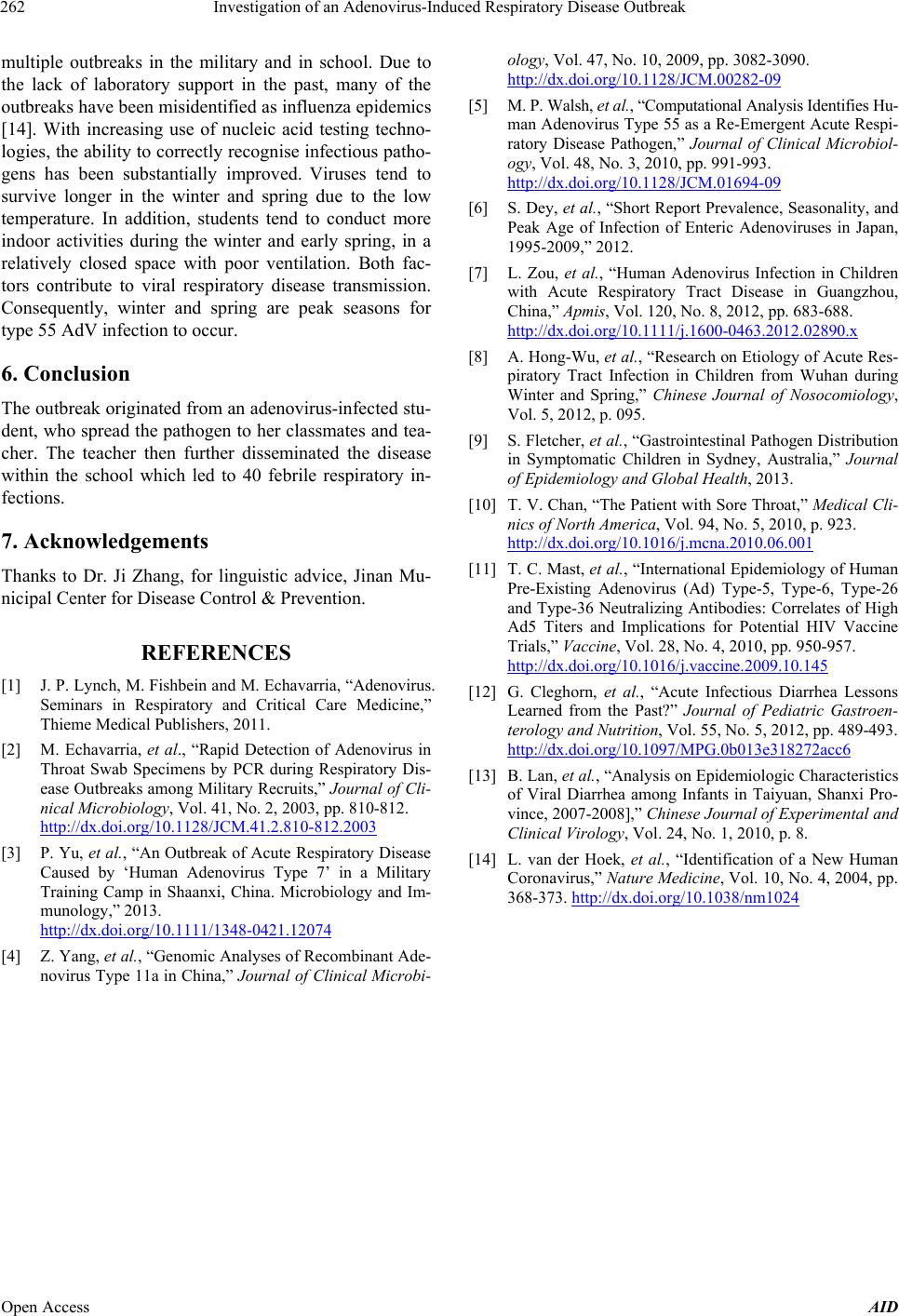
Investigation of an Adenovirus-Induced Respiratory Disease Outbreak
262
multiple outbreaks in the military and in school. Due to
the lack of laboratory support in the past, many of the
outbreaks have been misidentified as influenza epidemics
[14]. With increasing use of nucleic acid testing techno-
logies, the ability to correctly recognise infectious patho-
gens has been substantially improved. Viruses tend to
survive longer in the winter and spring due to the low
temperature. In addition, students tend to conduct more
indoor activities during the winter and early spring, in a
relatively closed space with poor ventilation. Both fac-
tors contribute to viral respiratory disease transmission.
Consequently, winter and spring are peak seasons for
type 55 AdV infection to occur.
6. Conclusion
The outbreak originated from an adenovirus-infected stu-
dent, who spread the pathogen to her classmates and tea-
cher. The teacher then further disseminated the disease
within the school which led to 40 febrile respiratory in-
fections.
7. Acknowledgements
Thanks to Dr. Ji Zhang, for linguistic advice, Jinan Mu-
nicipal Center for Disease Control & Prevention.
REFERENCES
[1] J. P. Lynch, M. Fishbein and M. Echavarria, “Adenovirus.
Seminars in Respiratory and Critical Care Medicine,”
Thieme Medical Publishers, 2011.
[2] M. Echavarria, et al., “Rapid Detection of Adenovirus in
Throat Swab Specimens by PCR during Respiratory Dis-
ease Outbreaks among Military Recruits,” Journal of Cli-
nical Microbiology, Vol. 41, No. 2, 2003, pp. 810-812.
http://dx.doi.org/10.1128/JCM.41.2.810-812.2003
[3] P. Yu, et al., “An Outbreak of Acute Respiratory Disease
Caused by ‘Human Adenovirus Type 7’ in a Military
Training Camp in Shaanxi, China. Microbiology and Im-
munology,” 2013.
http://dx.doi.org/10.1111/1348-0421.12074
[4] Z. Yang, et al., “Genomic Analyses of Recombinant Ade-
novirus Type 11a in China,” Journal of Clinical Microbi-
ology, Vol. 47, No. 10, 2009, pp. 3082-3090.
http://dx.doi.org/10.1128/JCM.00282-09
[5] M. P. Walsh, et al., “Computational Analysis Identifies Hu-
man Adenovirus Type 55 as a Re-Emergent Acute Respi-
ratory Disease Pathogen,” Journal of Clinical Microbiol-
ogy, Vol. 48, No. 3, 2010, pp. 991-993.
http://dx.doi.org/10.1128/JCM.01694-09
[6] S. Dey, et al., “Short Report Prevalence, Seasonality, and
Peak Age of Infection of Enteric Adenoviruses in Japan,
1995-2009,” 2012.
[7] L. Zou, et al., “Human Adenovirus Infection in Children
with Acute Respiratory Tract Disease in Guangzhou,
China,” Apmis, Vol. 120, No. 8, 2012, pp. 683-688.
http://dx.doi.org/10.1111/j.1600-0463.2012.02890.x
[8] A. Hong-Wu, et al., “Research on Etiology of Acute Res-
piratory Tract Infection in Children from Wuhan during
Winter and Spring,” Chinese Journal of Nosocomiology,
Vol. 5, 2012, p. 095.
[9] S. Fletcher, et al., “Gastrointestinal Pathogen Distribution
in Symptomatic Children in Sydney, Australia,” Journal
of Epidemiology and Global Health, 2013.
[10] T. V. Chan, “The Patient with Sore Throat,” Medical Cli-
nics of North America, Vol. 94, No. 5, 2010, p. 923.
http://dx.doi.org/10.1016/j.mcna.2010.06.001
[11] T. C. Mast, et al., “International Epidemiology of Human
Pre-Existing Adenovirus (Ad) Type-5, Type-6, Type-26
and Type-36 Neutralizing Antibodies: Correlates of High
Ad5 Titers and Implications for Potential HIV Vaccine
Trials,” Vaccine, Vol. 28, No. 4, 2010, pp. 950-957.
http://dx.doi.org/10.1016/j.vaccine.2009.10.145
[12] G. Cleghorn, et al., “Acute Infectious Diarrhea Lessons
Learned from the Past?” Journal of Pediatric Gastroen-
terology and Nutrition, Vol. 55, No. 5, 2012, pp. 489-493.
http://dx.doi.org/10.1097/MPG.0b013e318272acc6
[13] B. Lan, et al., “Analysis on Epidemiologic Characteristics
of Viral Diarrhea among Infants in Taiyuan, Shanxi Pro-
vince, 2007-2008],” Chinese Journal of Experimental and
Clinical Virology, Vol. 24, No. 1, 2010, p. 8.
[14] L. van der Hoek, et al., “Identification of a New Human
Coronavirus,” Nature Medicine, Vol. 10, No. 4, 2004, pp.
368-373. http://dx.doi.org/10.1038/nm1024
Open Access AID